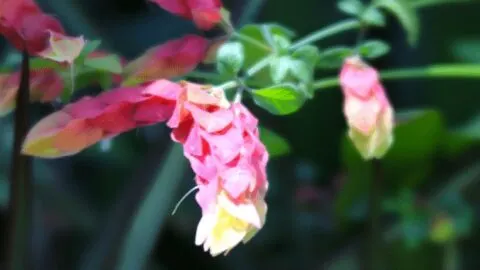You are reading this article to learn more about Shrimp plant care.
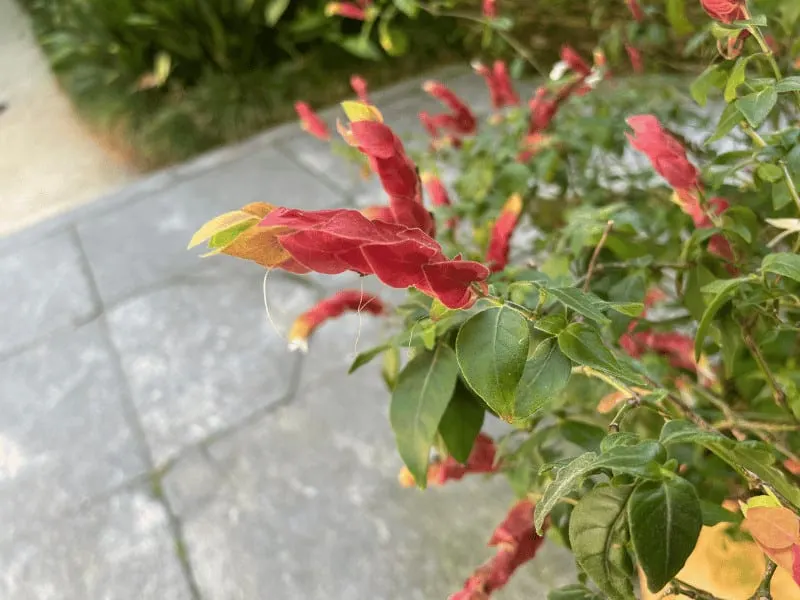
What is a Shrimp Plant?
Shrimp plants are native parts of Mexico and have since been widely populated in Florida. The scientific name is Justicia brandegeeana. Shrimp plants are perennials.
According to the University of IOWA, these plants belong to the Acanthaceae family.
You may have heard these evergreen shrubs be pronounced as the Mexican Shrimp plant or the False Hop.
This plant is easy to grow and can accent your home with year-round blooms of pinks, whites, and reds.
It grows iconic flower-like bracts that look like shrimps.
The white and red flowers attract both hummingbirds and butterflies.
The Shrimp plant is known for being resistant to drought.
| Species | Justicia brandegeeana |
| Synonyms | Shrimp Plant, Shrimp Flower, Mexican Shrimp Plant |
| Family | Acanthaceae |
| Genus | Justicia |
| Growth | Upright, bushy |
| Height | 3.0 feet |
| Width | 2.0 feet |
| Soil | Well-draining soil mix |
| Watering | Every 7-14 days |
| Light | Bright indirect |
| Temperature | 64.0°F - 84.0°F (18°C - 29°C) |
| Humidity | 50.0% - 70.0% |
| Fertilizer | Monthly |
| Propagation | Stem cuttings or division |
| Toxicity | Toxic to cats, dogs and humans |
| Species | Justicia brandegeeana |
Table of Contents
Shrimp Plant Care
To care for a Shrimp plant use well-draining sandy soil containing clay, sand, silt, and other organic matter. Provide it with bright indirect sunlight. Water once a week and keep the soil moist. The ideal temperature lies between 64-84°F (18 and 24 degrees Celsius). A humidity of 40% is ideal. Fertilize every 2 weeks using a liquid fertilizer at half strength in spring and summer until the end of autumn.
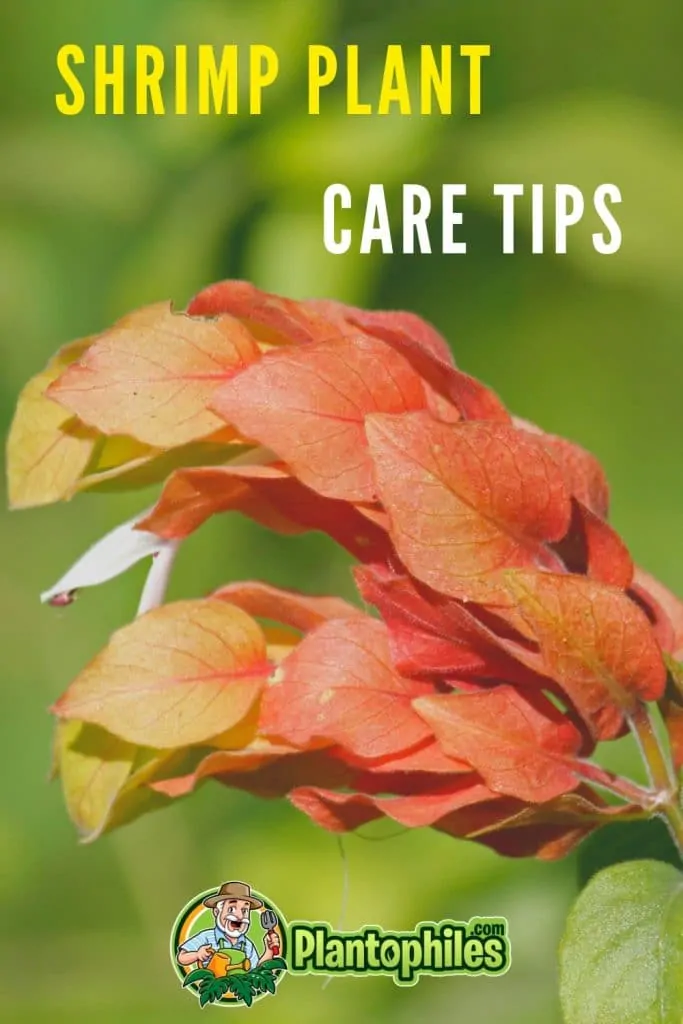
Soil
Justicia brandegeeana does not like salty soil.
Place it inside a pot with well-draining, sandy soil. Those with loamy soil will find their plants to be quite content.
This type of soil combines elements of clay, sand, silt, and other organic matter.
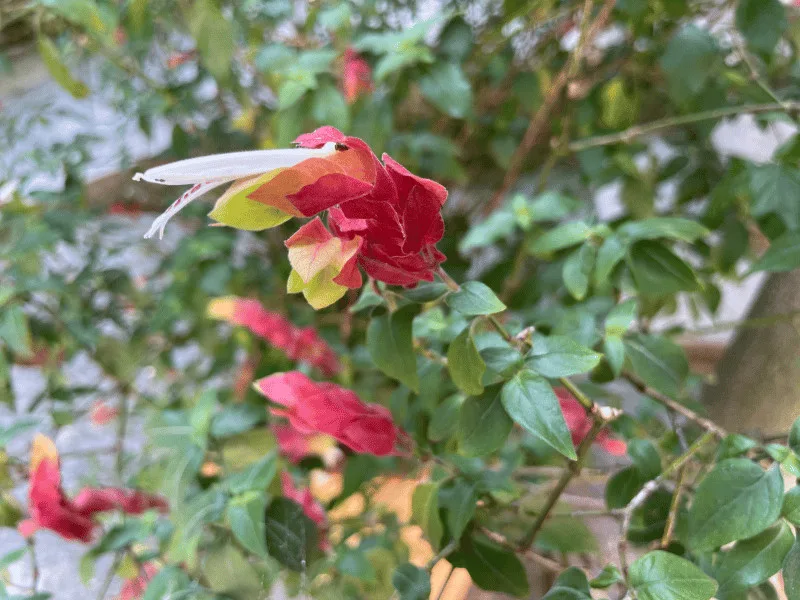
Light
The Mexican Shrimp plant prefers bright indirect sunlight.
The best window is an east-facing window with a couple of hours of direct sunlight in the morning (3-4 hours) and bright indirect light for the rest of the day.
Avoid direct sunlight for a prolonged time as it can burn the foliage.
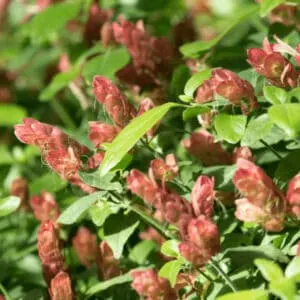
Watering
Water Justicia brandegeeana every 5-7 days. Shrimp plants prefer the soil to be evenly moist. If the soil is too dry you rish leaf drop.
Add enough water to completely dampen the soil surrounding the roots.
The only time you’ll want to dial it down a notch is in winter when the Shrimp plant doesn’t need as much moisture.
Avoid spraying the plant using a spray bottle. This will result in the bracts rotting.
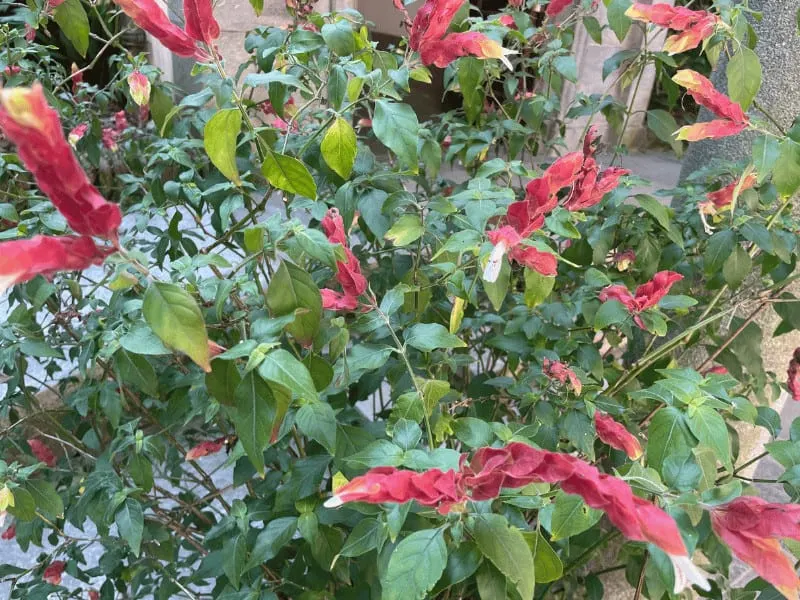
Temperature
Shrimp plants prefer temperatures between 64-84°F (18 and 24 degrees Celsius). The shrimp plant hardiness zone is 8-11, according to USDA.
This plant is sensitive to frost and not frost-hardy.
If you live in a colder area, keep it indoors in autumn and winter and only place it outside if temperatures are above 64 degrees Fahrenheit (18 degrees Celsius).
Be careful to not let the temperature drop below 54°F (12°C). This can severely damage your plant.
Humidity
The Shrimpl plant does well in humidity between 50-70%.
This evergreen bush is native to the tropical forests of Mexico. They need a fair amount of humidity to thrive.
Use a humidifier, and put plants closely together. You can also use a pebble tray with water underneath the pot to increase the humidity.
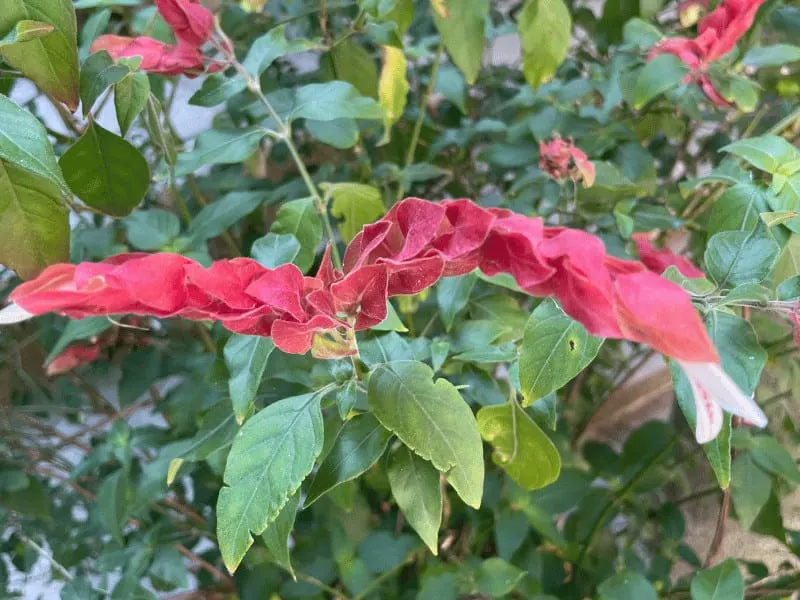
Fertilizer
Fertilize a Shrimp plant every two weeks in spring and summer until fall using a liquid fertilizer at half-strength.
In order to get those lovely blooms, a regular feeding schedule is essential.
Slowing down or canceling your fertilization use in other months is recommended.
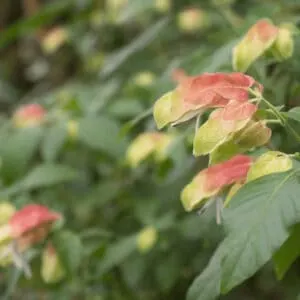
Shrimp plant Propagation
Shrimp plants can be propagated through stem cuttings or division.
Propagation Through Cuttings
- To begin propagation through stem cuttings, you’ll want to choose a healthy plant.
- Make several cuts directly below the leaf, about three to five inches long. There need to be at least two present leaves remaining on the stem.
- Take the stem and carefully take away any of the leaves located on the lower half.
- The newly cut stems will then be planted in a container with new soil, the open end dipped in the soil.
- Lightly mist the soil so that it becomes damp, and then place the stem cutting and the pot into a sealable bag.
- Choose a spot with bright, indirect sunlight and keep the soil slightly damp with occasional misting sessions.
- Once you notice roots start to appear, remove the plastic bag and transplant the individuals into a larger container.

Propagation by Division
- Choose a Shrimp plant that has outgrown its pot and needs to be replanted.
- Carefully remove the plant from its current pot.
- Divide the parent plant into two or three individuals by separating the roots.
- Repot the newly divided Shrimp plants into pots with fresh soil.
- Continue to keep the plant moist and place it in an area with plenty of sunshine, being careful not to overexpose them to bright or direct light.
Shrimp plant size
Shrimp plants in tropical locations in the ground can grow five feet tall (1.5 meters). It takes a while for them to reach this height.
If you nurture them in a pot, then you’ll find that they tend not to exceed two feet (0.6 meters).
Potting
Repot a Mexican Shrimp plant every year to avoid it becoming root or pot-bound.
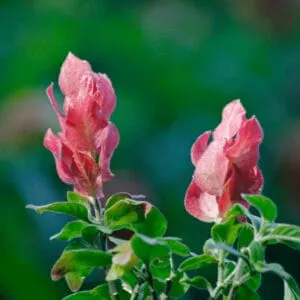
Shrimp Plant Colors
Shrimp plants are available in purple, pink, yellow, and white. The bracts are what is colored. The flowers are white. They bloom year-round.
How to prune Justicia brandegeeana
Some species are trickier to prune, becoming brown or dried when too much is taken away. The Shrimp plant relies on routine pruning to stay healthy. So, how does one exactly go about doing this?
The purpose of pruning a plant is to keep it healthy. Many also choose to cut back their household foliage because it simply looks good.
The best way to start pruning is to make sure that you have the right tools. Invest in a good shearing tool if you don’t have one already. Keeping it sharp and sanitized is also key. Look over your plant, starting at the outer regions.
Make small cuts to the outermost stems, leaving the stems at the center of the plant, as they need to be the longest. This is where the natural growth occurs, so it’s best to leave these areas alone.
If you notice any dead flowers or dead stems, take them out.
When to prune?
The most obvious signs that your Shrimp plant may need a good trim is when it becomes what’s known as “leggy”. This is where the stems start to grow out much longer than the rest of the plant.
The typical Justicia will need to be pruned about once a year. Of course, any damaged or dead parts of the plant can be removed long before then. The goal of pruning is to encourage the plant to bloom. This can only be done if the plant is healthy.
My Shrimp Plant is Yellow
Cause: This sudden change in color usually indicates that the Shrimp plant is overwatered, underwatered, infested with pests, or had too much sunlight.
Remedy: Adjust the watering routine until you find the right schedule. Check for pests and move the plant to a location with bright indirect sunlight.
The Shrimp Plant’s leaves Are Drooping
Cause: The cause for droopy leaves a dry conditions or if the plant is too cold.
Remedy: Check if the soil is slightly wet. If it is completely dry give it a good soak. Moving your plant to a location where the temperatures are within 64-84°F (18 and 24 degrees Celsius).
Do Shrimp Plants Freeze?
Shrimp plants freeze in temperatures below 50 degrees Fahrenheit (10 degrees Celsius).
Is the Shrimp Plant Toxic to Dogs?
Shrimp plants are not toxic to dogs, cats, and humans. However, avoid your pets from chewing on this plant and keep small children away. If you see your animal or a small child eating this plant, watch them closely for any adverse effects.
Are Shrimp Plants Deer Resistant?
Shrimp plants are deer-resistant. Deer will not try to munch on these plants.
Is Justicia brandegeeana a perennial?
The Shrimp plant is a tropical perennial blooming year-round.
Is the False Hop invasive?
These plants are considered to be both invasive and a weed. Naturally found in Mexico, these plants have been naturalized in Florida. The shrimp-like bracts and blooms are too compelling to avoid.
I hope this Shrimp plant care guide was helpful!

Daniel has been a plant enthusiast for over 20 years. He owns hundreds of houseplants and prepares for the chili growing seasons yearly with great anticipation. His favorite plants are plant species in the Araceae family, such as Monstera, Philodendron, and Anthurium. He also loves gardening and is growing hot peppers, tomatoes, and many more vegetables.

